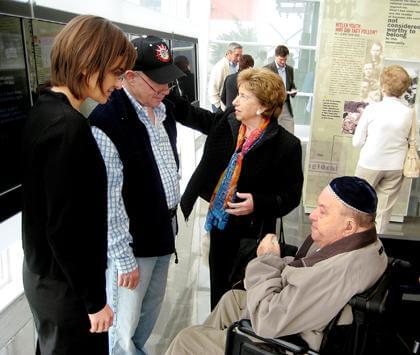By Nathan Duke
More than 50 Holocaust survivors took part in a special ceremony last week at Queensborough Community College’s long-awaited Holocaust center, where speakers said they hoped the 9,000-square-foot structure of glass, steel and Jerusalem stone would stand as a beacon of tolerance for years to come.
The Harriet and Kenneth Kupferberg Holocaust Resource Center and Archives will officially open Oct. 18 following five years of planning for the $6 million facility. The center, which had been in the basement of the Bayside school’s library since 1983, was named after late Malba philanthropist Harriet Kupferberg, who donated $1 million to the center, and her husband.
“This undertaking was a very important obligation so what happened to the survivors of the Holocaust would not be forgotten,” said Arthur Flug, the center’s executive director. “We wanted to make a special effort that their stories would become a part of our educational program.”
On Friday, the center held a pre-opening ceremony for a group of Holocaust survivors, many of whom were interviewed and featured in displays at the center. The survivors said they were pleased students at the school would hear their stories.
“My story is not the usual story,” said Eddie Weinstein, a Little Neck resident who escaped Poland’s Treblinka death camp at the age of 18 as well as fleeing five other times after being recaptured by the Nazis. “It’s a story about daring to resist. I escaped six times. The longest time I was incarcerated was 23 days and the shortest time was 24 hours. I kept running, I survived.”
Diana Albert of Little Neck said she escaped the Warsaw ghetto at age 9, but most of her family was killed. She eventually fled to the United States and later attended Queensborough.
“I was the only survivor from my entire family,” said Albert, whose brother, father, mother, aunts and cousins died during the Holocaust. “It’s good we now have a place to get together where people who have this in common can talk about these things.”
The center includes a permanent interactive exhibit that merges personal accounts with historical data, a gallery, customized exhibits and catalogs, a program that will train teachers and students about how to deal with hate crimes, a terrace adjacent to the center and a 150-foot space that will be used for outdoor events.
It will also host a variety of events, including a series of films created in Hollywood during World War II to torment Hitler’s regime as well as a bi-monthly program of Yiddish film, music, speakers, books and discussion groups for Holocaust survivors.
Flug said the center will also hold an upcoming event during which grandchildren will be able to trace their grandparents’ stories. The interviews between them will be captured on film.
The center’s exhibit has a timeline of the Holocaust as well as interviews with a number of survivors. One classroom in the building features a history of genocides throughout the past 100 years in nations such as Rwanda, Darfur and Armenia.
Eduardo Marti, Queensborough’s president, said he wants the college’s donors to put together a $5 million endowment for the center to ensure its building remains a Holocaust center.
“I want to make sure that students 100 years from now are learning the lessons of the Holocaust,” he said. “I know that the 15,000 students on this campus come from 130 different countries and a lot of them do not know about World War II or the Holocaust. But all of them, at one point, have been the subject of bullying. So this is not a memorial or a museum. It’s a laboratory, a classroom where we use the lessons of the Holocaust to teach students about prejudice to ensure something like this never happens again. We can teach the lesson that unless students speak up, something like the Holocaust can take place and become institutionalized.”
Reach reporter Nathan Duke by e-mail at nduke@cnglocal.com or by phone at 718-229-0300, Ext. 156.
































